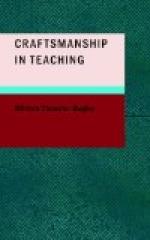The second hopeful feature of the task of supervision in respect of inspiration is that this “spirit” is an extremely contagious and pervasive thing. In other words, the principal or the superintendent may dominate every classroom under his supervision, almost without regard to the limitations of the individual teachers. Typical schools in every city system bear compelling testimony to this fact. The principal is the school.
And if I were to sum up the essential characteristics of the ideal supervisor, I could not neglect this point. After all, the two great dangers that beset him are, first, the danger of sloth—the old Adam of laziness—which will tempt him to avoid the details, to shirk the drudgery, to escape the close and wearisome scrutiny of little things; and, secondly, the sin of triviality—the inertia which holds him to details and never permits him to take the broader view and see the true ends toward which details are but the means. The proper combination of these two factors is all too rare, but it is in this combination that the ideal supervisor is to be found.
FOOTNOTES:
[Footnote 10: A paper read before the fifty-second annual meeting of the New York State Association of School Commissioners and Superintendents, November 8, 1907.]
V
THE SUPERVISOR AND THE TEACHER
I
It is difficult not to be depressed by the irrational radicalism of contemporary educational theory. It would seem that the workers in the higher ranges of educational activity should, of all men, preserve a balanced judgment and a sane outlook, and yet there is probably no other human calling that presents the strange phenomenon of men who are called experts throwing overboard everything that the past has sanctioned, and embarking without chart or compass upon any new venture that happens to catch popular fancy. The non-professional character of education is nowhere more painfully apparent than in the expression of this tendency. The literature of teaching that is written directly out of experience—out of actual adjustment to the teaching situation—is almost laughed out of court in some educational circles. But if one wishes to win the applause of the multitude one may do it easily enough by proclaiming some new and untried plan. At our educational gatherings you notice above everything else a straining for spectacular and bizarre effects. It is the novel that catches attention; and it sometimes seems to me that those who know the least about the educational situation in the way of direct contact often receive the largest share of attention and have the largest influence.




